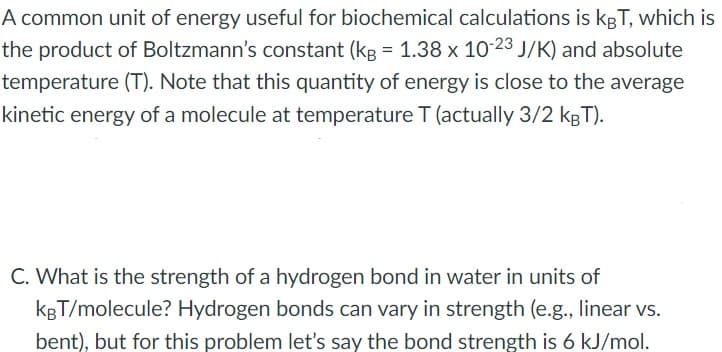An antibody (Ab) can bìnd to its antigen binding site (B) with a high affinity (large negative AG°). The antibody and the antigen are mixed at low concentrations and allowed to reach equilibrium. The concentrations measured are [Ab] = 1 nM, [B] = 40 %3D nM, and [Ab-B] = 30 nM, for the equilibrium Ab +B=Ab-B. Imagine that this binding were due entirely to hydrogen bonds. Referring to question 3C above, how many hydrogen bonds would form between Ab and B upon binding? If you were going to manufacture a coronavirus test kit with an antibody that tightly binds to an antigen found in the virus, would you want the antibody/antigen binding to have a Ka in the nM, µM, or mM range? Why?
An antibody (Ab) can bìnd to its antigen binding site (B) with a high affinity (large negative AG°). The antibody and the antigen are mixed at low concentrations and allowed to reach equilibrium. The concentrations measured are [Ab] = 1 nM, [B] = 40 %3D nM, and [Ab-B] = 30 nM, for the equilibrium Ab +B=Ab-B. Imagine that this binding were due entirely to hydrogen bonds. Referring to question 3C above, how many hydrogen bonds would form between Ab and B upon binding? If you were going to manufacture a coronavirus test kit with an antibody that tightly binds to an antigen found in the virus, would you want the antibody/antigen binding to have a Ka in the nM, µM, or mM range? Why?
Biochemistry
9th Edition
ISBN:9781319114671
Author:Lubert Stryer, Jeremy M. Berg, John L. Tymoczko, Gregory J. Gatto Jr.
Publisher:Lubert Stryer, Jeremy M. Berg, John L. Tymoczko, Gregory J. Gatto Jr.
Chapter1: Biochemistry: An Evolving Science
Section: Chapter Questions
Problem 1P
Related questions
Question
Question 3C would be the first image or the image with only one question on it
![An antibody (Ab) can bind to its
antigen binding site (B) with a high affinity (large negative AGO). The
antibody and the antigen are mixed at low concentrations and allowed to
reach equilibrium. The concentrations measured are [Ab] = 1 nM, [B] = 40
nM, and [Ab-B] = 30 nM, for the equilibrium Ab + B= Ab-B.
Imagine that this binding were due entirely to hydrogen bonds.
Referring to question 3C above, how many hydrogen bonds would form
between Ab and B upon binding?
If you were going to manufacture a coronavirus test kit with an antibody
that tightly binds to an antigen found in the virus, would you want the
antibody/antigen binding to have a Ka in the nM, µM, or mM range?
Why?](/v2/_next/image?url=https%3A%2F%2Fcontent.bartleby.com%2Fqna-images%2Fquestion%2F29d7278f-4991-4253-afc9-748fe0f71b33%2F5e6fe955-42ae-490a-beb5-761e5a551ee6%2Fnauktxm_processed.jpeg&w=3840&q=75)
Transcribed Image Text:An antibody (Ab) can bind to its
antigen binding site (B) with a high affinity (large negative AGO). The
antibody and the antigen are mixed at low concentrations and allowed to
reach equilibrium. The concentrations measured are [Ab] = 1 nM, [B] = 40
nM, and [Ab-B] = 30 nM, for the equilibrium Ab + B= Ab-B.
Imagine that this binding were due entirely to hydrogen bonds.
Referring to question 3C above, how many hydrogen bonds would form
between Ab and B upon binding?
If you were going to manufacture a coronavirus test kit with an antibody
that tightly binds to an antigen found in the virus, would you want the
antibody/antigen binding to have a Ka in the nM, µM, or mM range?
Why?

Transcribed Image Text:A common unit of energy useful for biochemical calculations is kgT, which is
the product of Boltzmann's constant (kg = 1.38 x 10-23 J/K) and absolute
temperature (T). Note that this quantity of energy is close to the average
kinetic energy of a molecule at temperature T (actually 3/2 kgT).
C. What is the strength of a hydrogen bond in water in units of
kgT/molecule? Hydrogen bonds can vary in strength (e.g., linear vs.
bent), but for this problem let's say the bond strength is 6 kJ/mol.
Expert Solution
Step 1
The antibodies bind to its antigen via non n covalent interactions like hydrogen bonding, hydrophobic interactions and van der waals interaction. The dissociation Kd is the concentration of ligand at which half the ligand binding sites on the protein are occupied in a system residing in equilibrium. The dissociation Kd and affinity are between Antibody and antigen are inversely related.
Trending now
This is a popular solution!
Step by step
Solved in 2 steps with 1 images

Recommended textbooks for you

Biochemistry
Biochemistry
ISBN:
9781319114671
Author:
Lubert Stryer, Jeremy M. Berg, John L. Tymoczko, Gregory J. Gatto Jr.
Publisher:
W. H. Freeman

Lehninger Principles of Biochemistry
Biochemistry
ISBN:
9781464126116
Author:
David L. Nelson, Michael M. Cox
Publisher:
W. H. Freeman

Fundamentals of Biochemistry: Life at the Molecul…
Biochemistry
ISBN:
9781118918401
Author:
Donald Voet, Judith G. Voet, Charlotte W. Pratt
Publisher:
WILEY

Biochemistry
Biochemistry
ISBN:
9781319114671
Author:
Lubert Stryer, Jeremy M. Berg, John L. Tymoczko, Gregory J. Gatto Jr.
Publisher:
W. H. Freeman

Lehninger Principles of Biochemistry
Biochemistry
ISBN:
9781464126116
Author:
David L. Nelson, Michael M. Cox
Publisher:
W. H. Freeman

Fundamentals of Biochemistry: Life at the Molecul…
Biochemistry
ISBN:
9781118918401
Author:
Donald Voet, Judith G. Voet, Charlotte W. Pratt
Publisher:
WILEY

Biochemistry
Biochemistry
ISBN:
9781305961135
Author:
Mary K. Campbell, Shawn O. Farrell, Owen M. McDougal
Publisher:
Cengage Learning

Biochemistry
Biochemistry
ISBN:
9781305577206
Author:
Reginald H. Garrett, Charles M. Grisham
Publisher:
Cengage Learning

Fundamentals of General, Organic, and Biological …
Biochemistry
ISBN:
9780134015187
Author:
John E. McMurry, David S. Ballantine, Carl A. Hoeger, Virginia E. Peterson
Publisher:
PEARSON